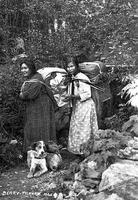Gitksan
GITKSAN ( ), or Gitxsan, are a FIRST NATIONS people whose territory encompasses the upper valley of the SKEENA R, from its headwaters in the mountainous Interior west to KITSELAS CANYON near TERRACE. They are closely related linguistically and culturally to their TSIMSHIAN neighbours. Gitksan means "people of the Skeena River." They divide their land into 63 "house territories," each represented by a hereditary chief. Many generations ago, according to their traditions, they lived together in a huge village, TEMLAXHAM (also known as Dimlahamid), southwest of HAZELTON. It was destroyed in an upheaval and the people dispersed. Today they number about 7,000, many living in 6 main communities: GITWANGAK, GITANYOW (Kitwancool), KITSEGUECLA, Gitanmaax (Hazelton), Sikokoak (GLEN VOWELL) and Anspayakws (KISPIOX). The traditional subsistence activity was FISHING for SALMON, supplemented by other fishing, hunting and gathering. Winter villages were substantial communities of CEDAR plank houses (see ARCHITECTURE, ABORIGINAL); during spring and summer the people migrated to a variety of resource sites. The POTLATCH and other ceremonies validated a complex hierarchical social system and the Git ksan achieved a superior level of artistic output, including TOTEM POLES and other elaborate carved and woven items (see ART, NORTHWEST COAST ABORIGINAL). They were active traders; it was via their neighbours that they first made contact with European trade goods. Direct contact with whites did not occur until the construction of the COLLINS OVERLAND TELEGRAPH through their territory in the 1860s. Since that time the Gitksan have become involved in LOGGING and commercial FISHING, but they have consistently resisted encroachments on their land by outsiders. Their system of 4 matrilineal clans (Frog, Wolf, Fireweed and Eagle) is maintained through the li'ligit (potlatch), in which traditional names are passed from one generation to the next, memorial "obligations" are fulfilled by heirs, and marriage and other events are put on record. In 1970 'KSAN, modelled on a 19th-century Gitksan village, was opened as a cultural centre and exhibit site in Hazelton, fostering a flourishing of traditional carving and art. Most recently the Gitksan joined the WET'SUWET'EN people of the Bulkley Valley in a land claims case that went all the way to the Supreme Court of Canada (see DELGAMUUKW CASE). See also ABORIGINAL RIGHTS.
Reading: Terry Glavin, A Death Feast in Dimlahamid, 1998.

